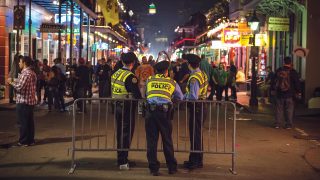
You know what shame looks like — head down, avoiding eye contact and hiding. It makes one appear less than and weaker than the other. Although it can act as a barrier to full and effective resolution of trauma, it is a survival resource and, therefore, can stick like glue for years. It is a signal of danger. It functions as a defense strategy to limit damage in situations where non-submission might provoke very serious attacks or rejections.
Think about the look of a DV victim, the body language of Otto Warmbier when brought before the news conference in Pyongyang, or Cersei’s walk of atonement in Game of Thrones. Know that there is a neurobiological purpose to shame. It functions as an arousal blocker, which underscores its role in trauma survival. It is a braking system to limit potentially more dangerous outcomes. This is relevant for officers experiencing shame during and after trauma.
Shame is overcome through practice, not redemption. Practice is performing the same task over and over again until it becomes learned.
What shame looks like
Shame produces an implosion of the body. The outward physical manifestations may include a lowered head, closed or averted eyes, blushed face, shoulders slumped and curved upper body turning in on itself so as to be as small as possible. Shame may sound like stuttering, talking in an overly soft voice or even not talking at all. The desire is to hide.
Thoughts may include cynicism, negative and critical perceptions of self, and ruminating on the past (e.g., failures, rejections). These individuals tend to underestimate abilities, strengths, and even the control that they could flex in any given situation. They tend to be suspicious and distrustful of others. They tend to dread the future because they are anticipating more failures and rejections. They are hyper-focused on themselves and their perceived smallness. They are less aware of others.
Feeling embarrassed or humiliated is common in such situations. Feeling weak, helpless or “frozen” are often experienced. Feeling numb, detached or disconnected from the present moment can be present. These individuals may also feel emotionally flooded, overstimulated, hypervigilant, overly sensitive, nauseous, irritable, moody, keyed-up and fearful. Generally, they are emotionally dysregulated.
Their behaviors tend toward self-isolating, avoiding and withdrawing from others. Self-destructive behaviors (e.g., alcohol, pills) may occur whether others realize it or not. They tend to self-sabotage (e.g., opportunities, relationships), avoid unfamiliar or challenging situations and not stand up for themselves. They tend to conceal perceived shameful parts of themselves.
Neurobiological purpose of shame
The outward body signals of shame are generally perceived by others as submissive, compliant, amenable and appeasing. This is significant. Those signals are doing exactly what the shamed person (consciously or unconsciously) wants. They are conveying that they are not a threat; this is done for the purpose of avoiding further harm — physically or psychologically. As such, their shame functions as a damage limitation strategy. It is designed to de-escalate and/or escape from conflicts that might provoke very serious attacks or rejections. Shame serves the neurobiological purpose of survival, and it is universally understood and agreed that physical and emotional survival in law enforcement is paramount.
How to release shame
Engage in mindfulness. Mindfulness is a tool (and the key ingredient) in changing how shame is organized in the brain. What should you do? Notice. Be curious about the shame, not judgmental. Notice sequences of triggers, thoughts and feelings. Notice the behavioral urge when certain feelings are experienced. Do not act on the urge. Simply observe the urge. Observe the impact on the collapsing body.
Adjust body posture. Shame tends to be reinforced or exacerbated when the body collapses in on itself, and, as such, it can be mitigated by changing body posture. Lengthen the spine. Ground the feet. Bring the head up (or at least slowly turn the head and lift the chin). Do it one step at a time, if needed. Move toward standing tall and erect, shoulders squared, with full direct eye contact.
Select more positive, accurate words. Ruminating about (say) one’s worthlessness depletes self-esteem and self-confidence, and it becomes a colossal waste of time and precious energy because it is not accurate. All law enforcement personnel have inherent worth and dignity. The potential to serve and do good is omnipresent. So, consider replacing any negative or self-critical thoughts with more positive, rational thoughts. Regardless of how many mistakes may have been made in the past, remind oneself: I am competent. I am capable. Regardless of what one may have done or not done, tell yourself: I am worthy of love. Regardless of how badly the day, week, or year has been going, reach deep (if need be) to fill in the blank: I am grateful for …
Regulate neurobiological responses. Traumatic events often push the nervous system outside its ability to regulate itself. Fight or flight response tends to take over. As a result, officers report disturbances in sleep, appetite, mood, energy, focus and more. The psychological task is to calm the parasympathetic nervous system. This can be done through meditation, progressive muscle relaxation, physical exercise, yoga or other stretching, mind-body activities (e.g., tai chi, qi gong), breath control (e.g., diaphragmatic breathing, box breathing), playing with small children and pets, spending time in a serene natural environment (e.g., national parks, the beach, the mountains, the desert), or even just listening to nature sounds on YouTube. Sometimes, just focusing on a word that is peaceful or calming helps.
Engage in opposite action. If you want an emotion to stick around or increase (e.g., joy, peace), continue to engage in the positive actions that produce those feelings (e.g., taking that vacation, outdoor recreation, walking the dog). If you want an emotion to go away (e.g., shame), do the opposite action (e.g., stretch instead of hunch over). If you want the opposite action skill to work, you need to use it all the way and believe that it will work.
If tempted to collapse the body in on itself, engage in the opposite action (i.e., lengthen spine, lift head and chin). If tempted to think negatively or self-critically, engage in the opposite action (i.e., replace the negative, irrational thoughts with more positive rational ones). If tempted to ruminate about past failures or rejections, engage in the opposite action (i.e., reflect on one or more past successes). As a general rule, do not revisit the past unless for the feel-good stuff. If tempted to isolate or hide in shame, engage in opposite action (i.e., raise head up, make eye contact, pull shoulders back and up, maybe even take command presence).
Practice. Shame is overcome through practice, not redemption. Practice is performing the same task over and over again until it becomes learned. It allows one to execute a task (e.g., driving a black-and-white while monitoring the MDT, firing a taser, crisis negotiations) while using less and less active brain processing.
So, practice observing the urge to collapse the body. Practice being curious about it and withholding judgment. Practice lengthening the spine, grounding the feet, bringing the head and chin up, and making eye contact. Practice telling yourself: I am competent. I am capable. I am worthy of love. Practice regulating neurobiology by cultivating a lower emotional arousal on a daily basis; it will become a psychological vaccination against shame. Practice engaging in opposite action when tempted to engage in shame-related thoughts or behaviors. And practice healthy self-care strategies to offer your family and the world the best version of you.
As seen in the November 2022 issue of American Police Beat magazine.
Don’t miss out on another issue today! Click below:





